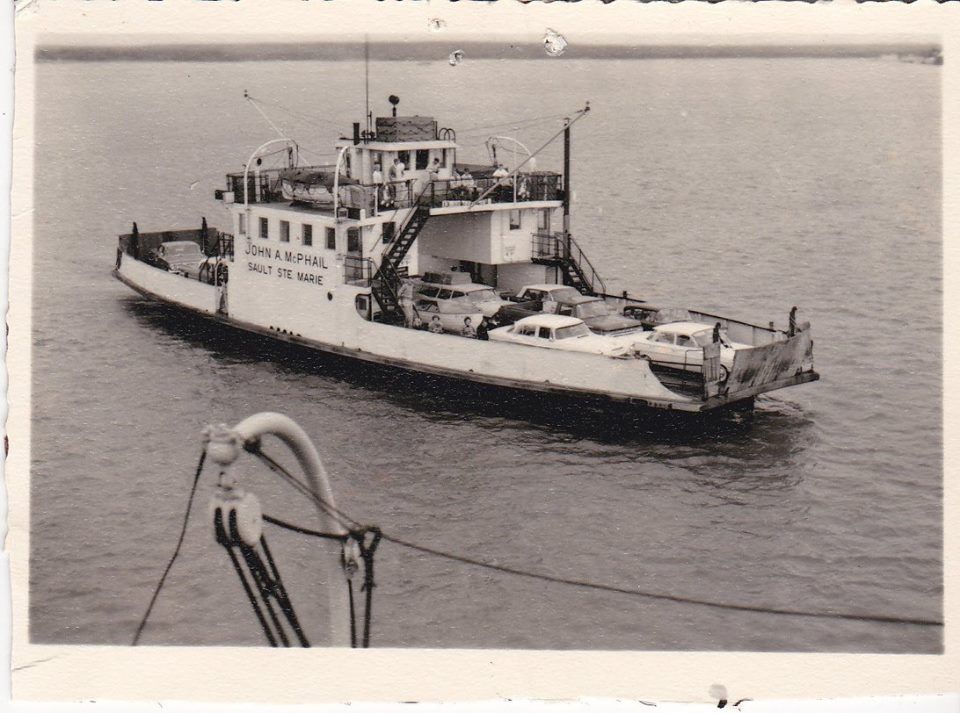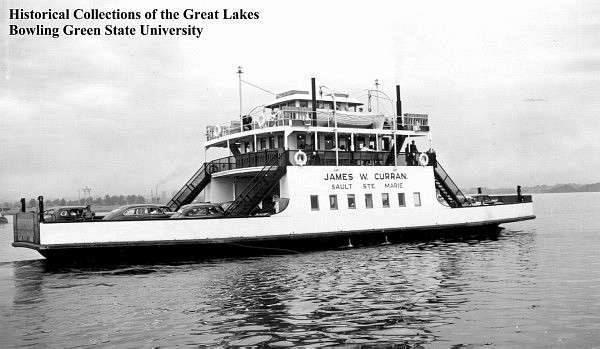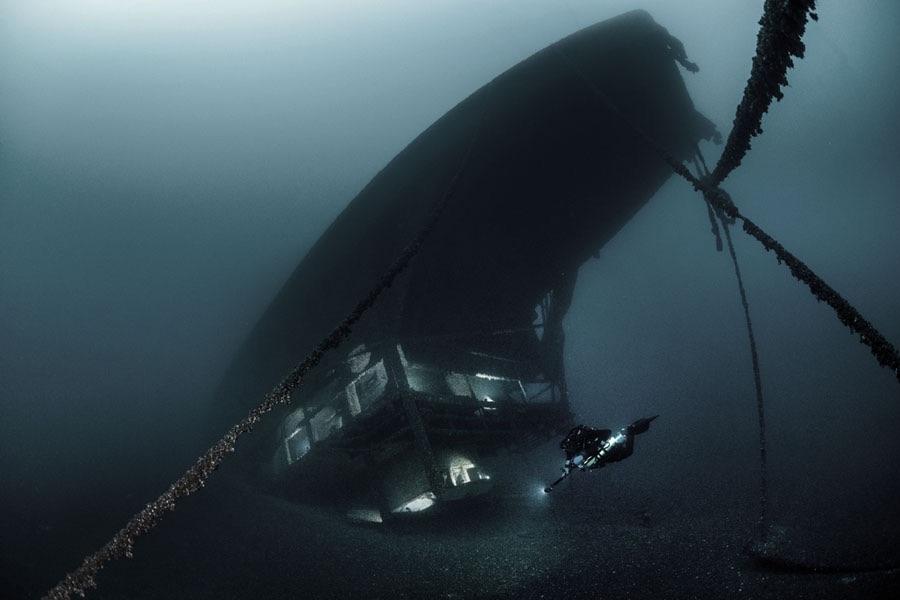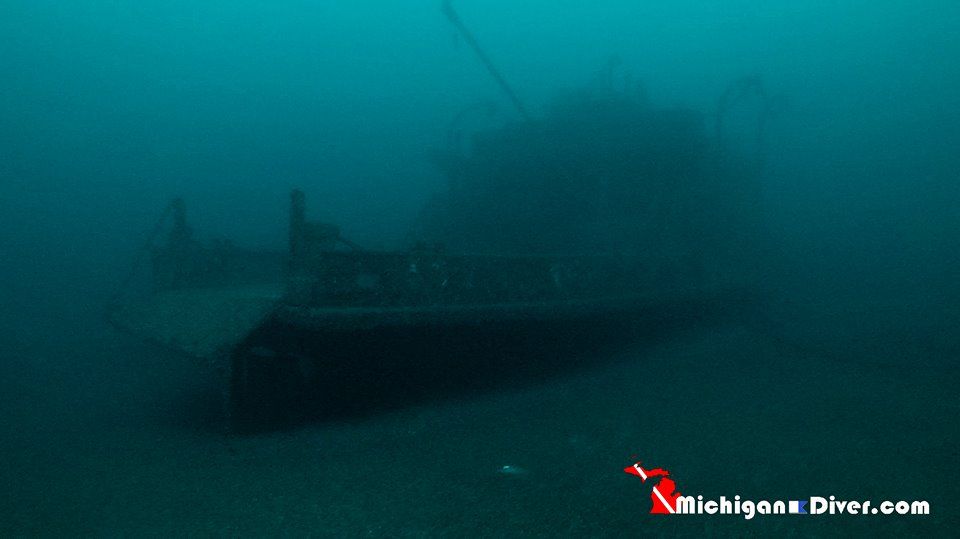Kingston Whig Standard, October 30, 1962: Wolfe Island council discusses relocating the Wolfe Islander.
Kingston Whig Standard November 15, 1962: James W. Curran and John A. McPhail replaced by new Soo bridge. Destined for Wolfe Island service if Islanders vote to change the location of the ferry landing.
Kingston Whig Standard March 26, 1964: New Islander: James W. Curran and a sister ship to run between Brophy’s point and Roger’s Side Road on a 15 minute schedule.
Kingston Whig Standard, May 11, 1964: Gilbert Harris of Port Arthur, skipper of the tug, was believed to be heading for shelter at Port Aux Baroque when the vessel nearest the Rogers began to go under.
So, the rumour mill was true. Two newer ferries will replace the Wolfe Islander. Word had been passed around now for quite some time in the village of Marysville. First, at ‘Marie’s’ the popular little restaurant, and the former ferry waiting room which had been moved to its present location in the early sixties.
Later, after Marie LaRush closed her popular soda fountain parlour, Ernie Allen opened his small diner in the middle of the village simply called ‘Ernie’s Lunch’. Here, heated debates about the future of their ferry service took place among the village folk and the farmers who lived out in the country. “Take it outside!” Ernie had said on more than one occasion. ‘Fueled’ heated, debates happened most Saturday nights at Greenwood’s hotel, now called The General Wolfe. Especially now, that they had their liquor license.

Sylvanus Apps, the MLA for the area now called Kingston and the Islands, was following through with his election promise of ‘free ferry service’. Advantage or not, many islanders, including Reeve Timothy O’Shea, still had high hopes for a bridge to the mainland. Free ferry service seemed a cheap compromise to the future of Wolfe Island. Free service will simply ‘swamp’ the boat with vehicles and passengers, many said. “And about this relocation business… It’ll kill the village,” others said. “Our business will go bankrupt… Many in the village don’t drive… I’ve never been to Brophy’s Point, other than by boat… Is there even a road out there?” And now, two new or partly used boats were coming to replace the Wolfe Islander. Fifteen minute service they said.
First one boat disappeared from sight. Then the other.
Starting out onto wide Lake Huron, the sea was choppy at best, with huge ominous clouds stretching up from the southwest. No problem, thought the captain. Slowly, with precision, the tug crew set out the towline for one ship, tethered behind the other, then set the wire for a long stretch behind the ship tethered to the tug itself. Two hours later, the down bound tug G W Rogers with her tow was heading into a west-southwesterly gale with winds reaching 35 to 40 knots. The waves were now reaching ten to fifteen feet high. Even higher in some places, the captain figured.
. . . . . . .
Under sunny skies with a partial cloud cover, the Canadian Dredge and Dock Company tug GW Rogers left Sault Ste. Marie at 6:40 am Friday, May 8, 1964, with two empty ferries in tow. Owned now by the Ontario Department of Highways, the ferries James W Curran and sister ship John A McPhail were on their way to Kingston. Once there, the vessels would wait until new docks and roads were complete for a new Wolfe Island to Kingston ferry run.
When completed, the ‘new’ boats would replace MS Wolfe Islander on a brand-new run about five miles east of Marysville on Brophy’s Point and link with Roger’s Side Road about five miles east of Kingston. While new to the area, the ferries had been in service for several years. The James W Curran was launched June 14, 1947 and the John A McPhail was launched June 4, 1955. Both vessels crossed the St. Mary’s River between the twin cities of Sault Ste. Marie in Michigan and Sault Ste. Marie, Ontario year-round for the International Transit Company. Both vessels were 115 feet long, 36 feet wide and could carry eighteen cars and 450 passengers each. Ownership moved to the Ontario Department of Highways in 1961. Both vessels were laid up when the new International Bridge connecting the two cities opened October 30, 1962.
Captain Gilbert Harris cautiously leaned out the open leeward door from the wheelhouse and looked back at his deckhands by the towing winch. “Pay ‘er out!” he yelled, waving his left arm backward. “Another damn shot, at least!” Far behind the G W Rogers the two empty ferries bobbed up one wave then down the other on the long towline. The first one, tethered to the tug about two hundred feet back, was the James W Curran. Tethered to the Curran, about another hundred feet behind was her sister ship the McPhail. As the ferries were built for the river, not the wide open expanse of Lake Huron, their hull rose up from the exposed chine which was the topside of the main vehicle deck to a raised steel bulwark of about 4 feet.
There were no large freeing ports, only small scuppers to allow accumulating water to run off. Again, there were adequate for their river run but not for the open lake if a sudden storm came up. A worried Captain Harris hoped it would be enough. The decision was made to continue the voyage.
While the GW Rogers pushed her own 93 feet into the heavy seas, her 1000 hp diesel engine whining at full power, Bert Harris looked back at his two towed ‘barges’. The 11/4 inch steel towline was well under the surface as the waves hit one ferry, then the other. The heavy, submerged towline acted as a buffer between tug and barges. Captain Harris wanted to reduce the sudden jerking even more by paying out more towline. If it parted in this weather there could be no hope of recovery.
The after well-deck of the tug was shipping more water than it could get rid of through the freeing ports while the two deckhands, decked out in rubber boots and nor’ westers, took it all in stride. One hand for the ship, one for me'self. Captain Harris called down to slow the engine a little. It just may slow the water we’re shipping, he hoped.
The earlier wind had dropped out by the time the tug G.W. Rogers cleared Detour Light and started out from the winding channel of the St. Mary’s River out onto the wide, open expanse of Lake Huron.
Captain ‘Bert’ Harris altered course just after clearing Detour light and steered on a southerly course toward Rogers City on the Michigan shoreline. Feeling a storm brewing, the seasoned shipmaster had re-plotted his course line. Captain Gilbert Harris, in his fifties now, was well seasoned. He had been a tugboat man for his entire career on the Great Lakes and was used to making changes in his estimates of arrival and courses to steer. A tugboat man’s life depended on these changes, especially in the fall or early winter and sometimes in the early spring. Listening to the repeated weather forecast foretelling strong westerly winds he opted for the American shoreline which he knew would be the leeward side should the seas start to build. He also had to consider safe haven harbours as well.

The crew were busy with the towline after they cleared Detour Light on their way to Lake Huron. First, while the tug idled slow ahead, they let out a good 100 feet or so for the fixed, wire towline between the two ferries while aboard the Curran. Next, Captain Harris backed slow allowing the deckhands to climb aboard the tug from the Curran. Once they were aboard, the mate indicated with a movement of his arm for the captain to go slow ahead. This allowed them to pay out the towline from the tug to the first tow. ‘Three shots’ the captain had wanted. On a regular ship this indicates a length of cable for anchoring. One shot equals 15 fathoms or 90 feet. In this case Harris wanted at least 270 feet of towline between the tug and first tow. This would allow for the cable to sink and absorb any sudden jerk of the towline.
Following down the American shoreline, Harris and his crew felt the seas building every hour. The deckhand acted as wheelsman steering his course while watching the gimballed compass heading in the bowl as it bounced about. Others watched the following seas travel ahead of the tug. Nobody spoke in the wheelhouse, especially about the building sea. Cigarette smoke drifted out the leeward door which was latched open. The brass clock mounted over the forward window showed three o’clock in the afternoon. Harris adjusted the radio once more to hear something about a tornado threat somewhere in Michigan. Everyone in the wheelhouse heard it. Again, no one spoke. Dark, heavy black cumulonimbus clouds were building just to their west. To the east out on the lake, whitecaps were starting to blow into spindrifts. Steering out from Presquile Isle light, they set their course to take them out further into the lake to clear Thunder Bay Island light, several miles ahead.
Later, after their very light supper, the mate and one deckhand decided to turn in, relieving the captain and wheelsman at midnight. Walking out of the wheelhouse, both men hung on to the railing of the walkway and stairs in the climbing seas. Above their heads, thick smoke billowed from the smokestack blowing ahead of the ship. Far behind them, fading light from the setting sun reflected the white superstructure of the two following ferries. Like earlier, first one disappeared behind the towering waves, then the other. They also appeared to be rolling. Heavily.
By midnight, the mate shuffled his way from his cabin to the tug’s galley. “By Jaysus man,” he said to the cook when he shut and dogged the door behind him. “God almighty hisself wouldn’t be out on a night like this. Coffee on?”
“Yeah, jes put a pot on not twenty minutes ago, Jack. Skipper wanted one. Says he’s gonn’a go through the night.”
Standing with his legs well apart, the cook lit another cigarette off the one he already had in his mouth and butted the stub out on a secured ashtray by the sink. “Friggin’ sea’s gettin’ worse.” Just then, a solid boom hit the bulkhead like a giant sledgehammer, followed by the sound of rushing water just outside the door.
“Man, you’re tellin’ me. The hell are we? Do ya know?”
“Somewhere’s off Au Sable Point, skipper said earlier. Passed it about 45 minutes ago I guess.”
“Any grub?” asked the mate.
The cook shook his head. “Nothin’ hot Jack. Cold cuts in the fridge.”
“Ugh… never mind. Couldn’t eat anythin’ anyways. Tossed around in my bunk since I laid down.”
“Yeah,” the cook replied, tossing his dishrag onto the counter. “I never lit the stove. Nobody wanted nothin’ hot so I secured everythin’ that wasn’t tossin’ about.”

The cook poured himself a brew and, tasting it, scrunched his face into a frown. Boom went the bulkhead again. The deck lifted like a freight elevator once more. Two washed plates slid off the counter, breaking as they hit the deck. The cook spilled the remainder of his brew on his hand and the tabletop. “Jaysus, mercy!” he yelled, throwing the cup toward the sink. Both men then sat down carefully at the long table which ran athwartships secured to the bulkhead. A bench, secured to the deck, ran along the table length closest to the bulkhead. Three wooden chairs were on the outer side. Along the table’s edge was a wooden strip about an inch high to prevent plates and cutlery sliding off. Cloth placemats were wetted down in the sink to stop plates from sliding, especially on a night like this.
“Should’a stayed at my job at the diner back at the Soo, Jack.”
Both men laughed. “I know, could’a, should’a, would’a,” the mate said, wincing as he sipped at his coffee while watching the hanging fly strip secured to the ceiling over the table sway with the motion of the ship. “You’d miss this, admit it.”
Just then the bulkhead door pulled open on the leeward side. The deckhand’s eyes were wide as he leaned in the doorway. “Mate, you gott’a come quick! Topside!”
Dropping his cup, the mate bolted for the door, leaving the cook to secure it shut. Climbing the forward stairs both men got sprayed as they hung on tightly to the rails while the Rogers climbed steeply up one wave and then slid down heavily into the trough. Another teeth rattling boom. Coming into the leeward wheelhouse door, which was already latched open, the mate noticed the spotlight was shining astern, toward the towed ferries.
Inside the wheelhouse, a cupboard door was open and several books and papers were on the deck sliding about. Solid water mixed with heavy spray was hitting the forward windows now, unlike before. Captain Harris was on the VHF radio to the U.S. Coast Guard station at Harbour Beach, Michigan. He glanced at the mate.
“Jack, I can only spot the boats now and then. The Curran’s leanin’ I think. Can’t see the McPhail. We better pay out more wire…”
“GW Rogers,” the VHF radio crackled, “say again your position, captain. Over.”
“Harbour Beach, we’re about 30 miles north of Pointe aux Barques. I have two ferries in tow and they're both rolling badly. I can only spot them now and then with the searchlight. The first one appears to be listing with little or no freeboard.”
Both the mate and the deckhand looked out the back windows cupping their hands to their eyes. The searchlight beam was dancing around the huge seas.
“GW Rogers this is Coast Guard Harbor Beach. Do you require assistance captain? Over.”
“Harbour Beach, the Rogers. Negative on that. I may need your help comin’ into Pointe aux Barques. We’re not makin’ much…”
“Captain!” It was the deckhand. Harris turned quickly. “It’s the Curran! She’s gone right over!”
Harris threw the radio mike. “Jack, the wire!” he yelled. “Pay her out! Or cut her loose! She’ll drag us down!” Cupping his eyes, the captain stared out the rear windows into the maelstrom. The light beam bounced on the hapless ship for an instant, showing her over on her starboard side sinking fast.
The mate was already out the door and flew down the forward stairs to the bow deck, gripping tightly to anything his hand could feel. The deckhand was directly behind. A sudden spray hit them full in the face before they could round the deckhouse. Hanging tight to the life rail secured to the bulkhead, both men waded into the almost knee deep water sloshing around the after deck and climbed up onto the winch platform. A small yellow light mounted on the upper end of the bulkhead feebly lit the area.

Feeling by memory, the deckhand gripped the handle of the steel peg used to keep the teeth of the huge gear from turning. As the mate fired the winch up, the huge gear moved back a fraction. The deckhand quickly moved it forward, allowing the metal pin to be released. Releasing the brake, the mate watched as the huge drum began to spin forward now, as coil after coil of wire rope disappeared over the stern. Bracing themselves against the violent, see-saw motion of the tug, both mate and deckhand tried looking out over the dark, black void directly astern. Lightning-like flashes from the wheelhouse searchlight only reflected the frighteningly huge waves astern. As the tug crested a wave, the light reflected suddenly on a white object only for a split second. The whine from the spinning drum drowned out any other noise.
The mate grabbed the brake wheel and started leaning on it. “Billy!” he yelled above the din, “Tell the skipper to back down! We’re gonn’a lose the wire!”
White hot sparks showered the afterdeck as metal on metal grinded, slowing the huge winch. Slowly the drum whined down. The sea boiled around the stern telling the mate that the tug had stopped. Again, the searchlight fell down to the sea. Both men stretched to look. Nothing. Nothing but a wall of black water with the wire disappearing in the dark depths. Then, as the stern lifted violently with the next wave, black, empty sky. Nothing could be seen of the Curran or the McPhail.

Dawn drew a bleak picture. The tug GW Rogers was ‘anchored’ by the stern, riding the swells of the day before at the mouth of Saginaw Bay, Lake Huron. The towline was holding fast to the now sunken ferry James W Curran, some 200 feet below the surface. While the McPhail remained afloat for a while, the tug’s crew were helpless to return to her aid and shortly before dawn, listing heavily, she slid beneath the waves.
Weather reports later indicated there was indeed a tornado in the Michigan area. Winds were reported gusting more than 80 miles per hour causing widespread damage between Windsor and Toronto, Ontario.
Reference: ‘Island Ferries Sink’ The Kingston Whig Standard, Monday, May 11, 1964. ‘Island Residents said Unhappy over Ferries’ The Kingston Whig Standard, Wednesday, May 13, 1964.
By Brian Johnson, Semi-retired captain, Wolfe Islander III
Captain Brian Johnson, semi-retired captain of Kingston's Ferry Wolfe Islander III has written over 45 articles for TI Life. He has taken us on several wild voyages - and I mean wild (weather and helmsmen alike). Everyone of them are reader favorites. Be sure to review the long list on our archived TI Life site, here.
Posted in: Volume 15, Issue 6, June 2020, History, People, Places, News article
Please click here if you are unable to post your comment.
